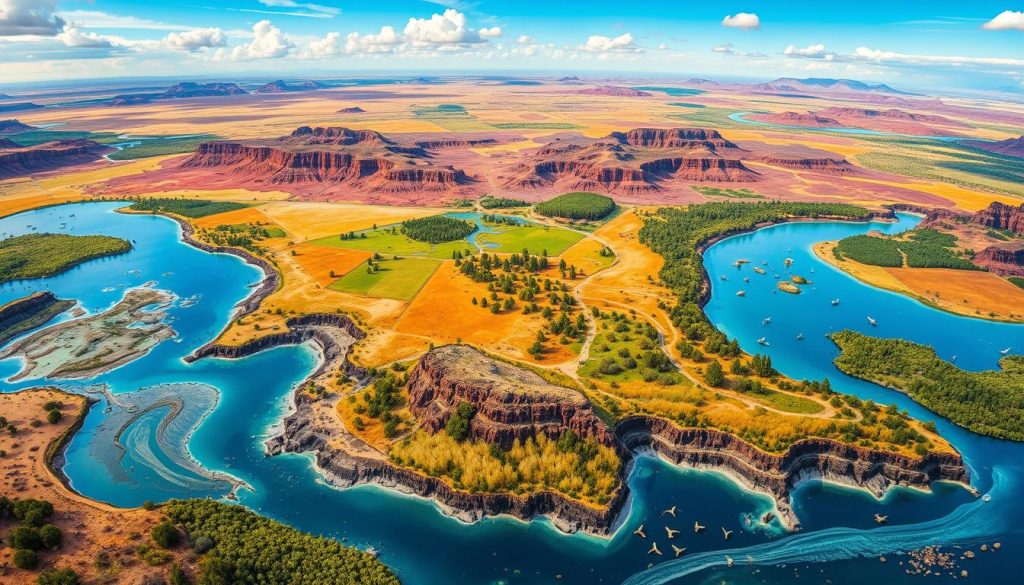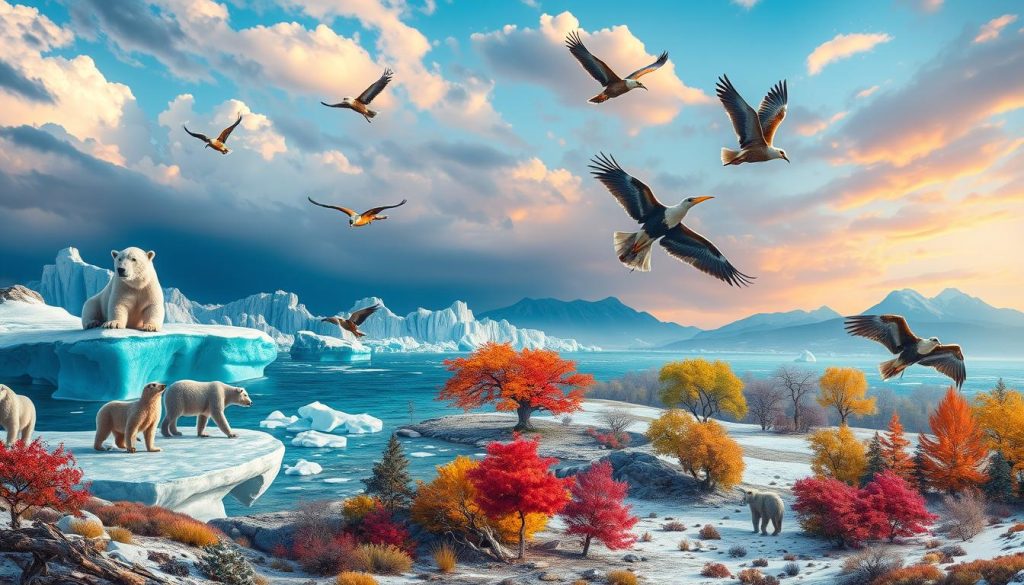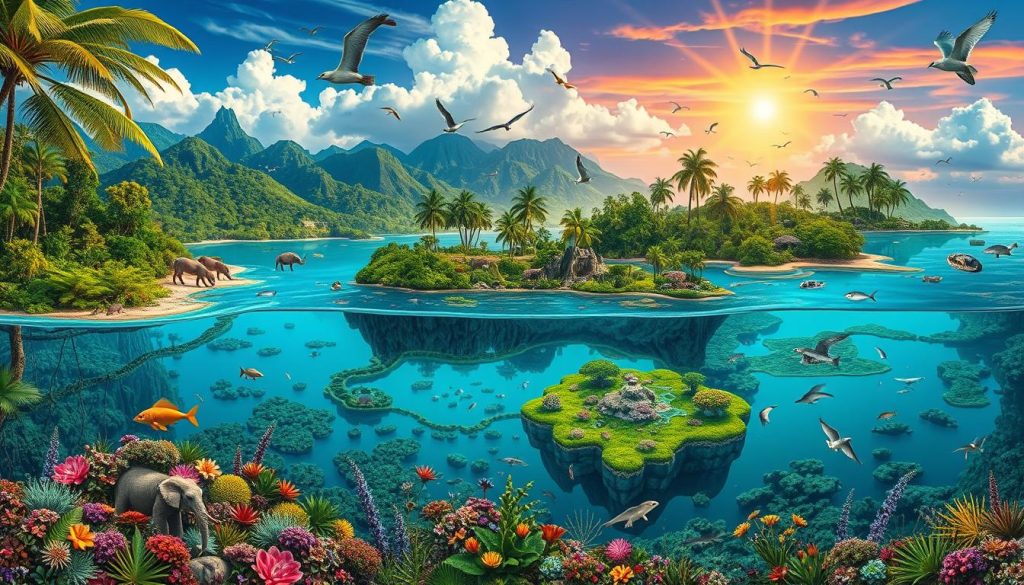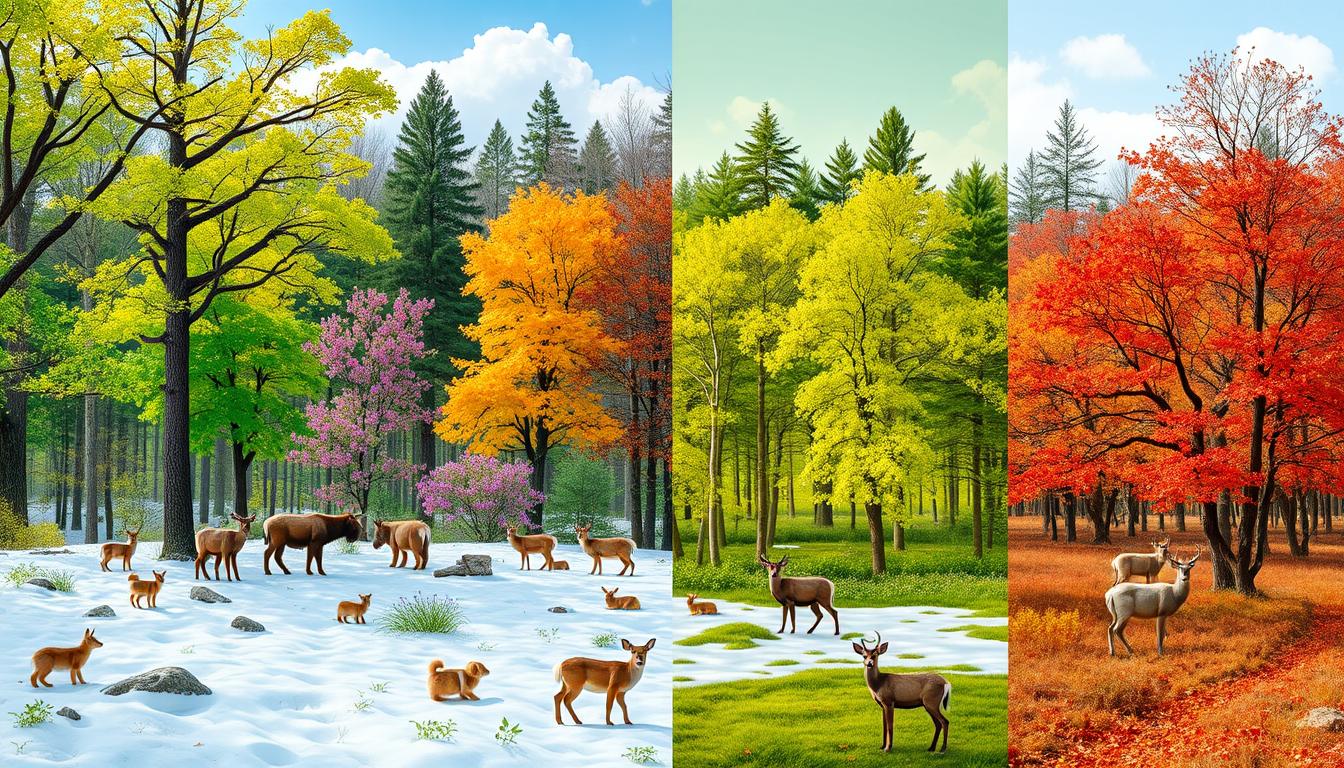Exploring the natural world, I’m constantly amazed by the amazing ways plants and animals adapt. From the bright colors of autumn leaves to the survival tactics of migratory birds, it’s clear that climate variability and other environmental factors shape species in North America.
Seasonal changes trigger dormancy in some plants, while regional differences affect wildlife distribution. This shows how living things adapt to their surroundings, a true marvel of evolution. In this article, I’ll dive into the science behind these adaptations and share my observations of nature’s resilience.
Understanding these adaptations helps us appreciate nature’s beauty and complexity. It also highlights the need to protect habitats and ecosystems. Let’s explore how plants and animals have adapted to their environments, both now and in the past.
Understanding Seasonal Adaptations in Nature
The natural world is full of change, where animals and plants adapt to survive the seasons. They show amazing flexibility and timing in their lives. This lets them adjust to the changing weather and times of the year.
The Science Behind Seasonal Changes
Seasonal adaptations involve complex changes in how animals and plants live. Thermoregulation is key when temperatures change. For example, the snowshoe hare changes its fur to stay warm and save energy in winter.
Examples of Seasonal Adaptations
The world is full of amazing seasonal adaptations. The monarch butterfly migrates thousands of miles to avoid cold winters. The black bear slows down its body to get through the hard times when food is hard to find.
How Adaptations Affect Animal Behavior
These adaptations not only help animals survive but also shape their behavior. Migration, mating, and finding food are all influenced by the seasons. Learning about these adaptations helps us understand the complex life on our planet.
Exploring Regional Adaptations

The diverse landscapes and climates across North America have shaped the remarkable adaptations of the flora and fauna. By exploring the intricate relationship between geographic distribution, habitat preferences, and ecological adaptation, we can gain a deeper understanding. This understanding reveals the ingenious ways in which species have evolved to thrive in their local environments.
Climate Influence on Species
From the arid deserts of the Southwest to the lush rainforests of the Pacific Northwest, climate shapes species. Species in harsh winters often develop fur coats or migrate to warmer climates. On the other hand, species in temperate or tropical regions may have bright colors or unique feeding strategies to exploit abundant resources.
Case Studies of Flora and Fauna
- The saguaro cactus, native to the Sonoran Desert, has a thick, waxy outer layer to reduce water loss. It stores moisture within its succulent flesh, thriving in the arid environment.
- The grizzly bear, found in the Pacific Northwest, has thick fur and a robust build. These adaptations help it withstand cold temperatures and navigate rugged terrain.
- The monarch butterfly has evolved to detect and navigate by the sun’s position. This ability enables it to travel thousands of miles between its breeding grounds in the United States and its overwintering sites in Mexico.
The Connection Between Geography and Survival
The diverse geographic features of North America deeply influence wildlife survival strategies. Species in areas with abundant resources and favorable conditions often have less pronounced adaptations. Those in more challenging environments have developed specialized adaptations to ensure their survival. Understanding these connections is crucial for conservation efforts and preserving the natural world’s remarkable diversity.
My Personal Observations of Local Wildlife
I’ve always been fascinated by the natural world. Since I was a kid, I’ve watched the wildlife in my area closely. The changes in my backyard and the differences across regions amaze me every time.
Seasonal Changes in My Backyard
Every year, I see big changes in the birds and mammals around me. In spring, the birds return with their bright songs and colors. Summer brings them out to forage and nest, adjusting to the warmer weather.
Regional Differences I’ve Noticed
- The variety of plants and animals in my area, each suited to its climate and land.
- The birds’ colors and how they eat change with the region’s environment.
- Animals move and act differently here, based on the weather and what’s available.
The Adaptations of Birds and Mammals
Watching local wildlife is truly amazing. Birds and mammals have evolved incredible ways to survive. Their migration patterns and how they stay warm in cold weather are just a few examples.
Studying these adaptations has deepened my respect for our ecosystem. It’s made me want to help protect these natural wonders. My observations have sparked a desire to contribute to their conservation.
The Role of Climate Change in Adaptations

Climate change is changing the natural world in big ways. It affects how species adapt, where they live, and how they change to survive. These changes are big and need our attention.
Shifts in Seasonal Patterns
Climate change is messing with the seasons. Birds are showing up to breed too early or too late. This messes up the food chain because predators and prey are out of sync.
Effects on Species Distribution
With warmer temperatures and changing rain, species are moving to new homes. This can push out native species and bring in new ones. It’s a big challenge for keeping ecosystems balanced.
How Animals Are Coping with Change
- Phenotypic plasticity: Some species are changing how they look and act to fit the new environment.
- Evolutionary adaptations: Over time, species might evolve to better handle climate change. But this change happens slowly.
- Habitat loss and migration: Many animals have to leave their old homes for new ones. But they often face tough competition and scarce resources.
We need to understand how climate change is affecting the natural world. By learning about ecological adaptation, geographic distribution, and phenotypic plasticity, we can help protect our planet’s ecosystems.
The Importance of Habitat Preservation

Keeping diverse habitats safe is key to the health of nature. Each ecosystem is a special place for many species. It lets them grow and develop traits that help them live well in their habitat preferences, environmental factors, and ecological adaptation.
Protecting Seasonal and Regional Adaptations
When habitats are harmed or lost, the balance needed for life is broken. Species may find it hard to meet their needs, leading to fewer numbers and even extinction. Protecting these places helps keep the natural world’s variety alive for future generations.
Local Initiatives and Conservation Efforts
- Many communities are leading efforts to save local wildlife and their homes.
- These actions include setting up nature reserves and wildlife paths. They also involve using land wisely and teaching people about it.
- Working together with local groups, authorities, and people, we can protect the special traits in our own areas.
My Involvement in Local Wildlife Conservation
I’ve been helping out in local conservation projects. I’ve volunteered at a nature center and helped restore wildlife habitats. Seeing the impact of our work has shown me how vital it is to protect our natural world.
By helping out and spreading the word, we can all make a difference. This ensures the wonders of nature around us keep thriving.
Conclusion: The Beauty of Adaptations in Nature
Reflecting on seasonal and regional adaptations in nature, I’m amazed by its beauty and ingenuity. The vibrant fall foliage and the resilience of species in diverse climates are awe-inspiring. These adaptations show the incredible diversity of life.
Reflecting on What I’ve Learned
I’ve grown to appreciate how climate variability and ecological adaptation shape our natural world. The way organisms adapt to their environmental factors is a marvel. It shows the elegance of nature’s design.
Future Observations to Consider
I’m excited to see how species adapt to environmental changes. These changes could alter ecosystems in new ways. Watching the natural world closely will help us understand these complex processes better.
Encouraging Others to Explore Nature
I hope my exploration of nature’s adaptations inspires others to explore outdoors. Whether it’s noticing changes in your backyard or traveling to new places, there’s always something new to discover. The natural world is full of wonders waiting to be seen.

